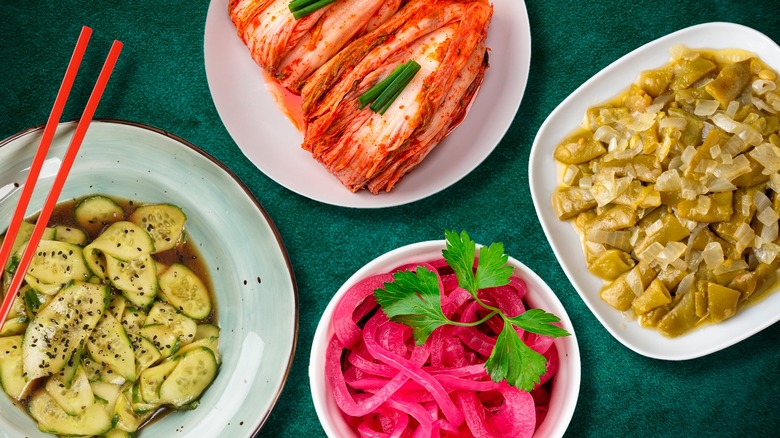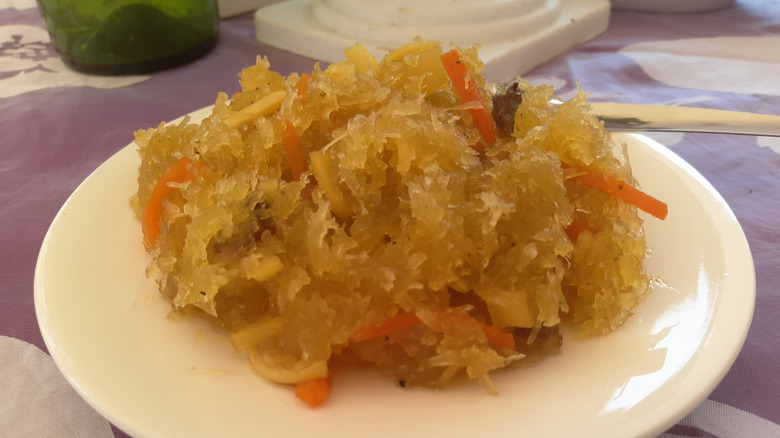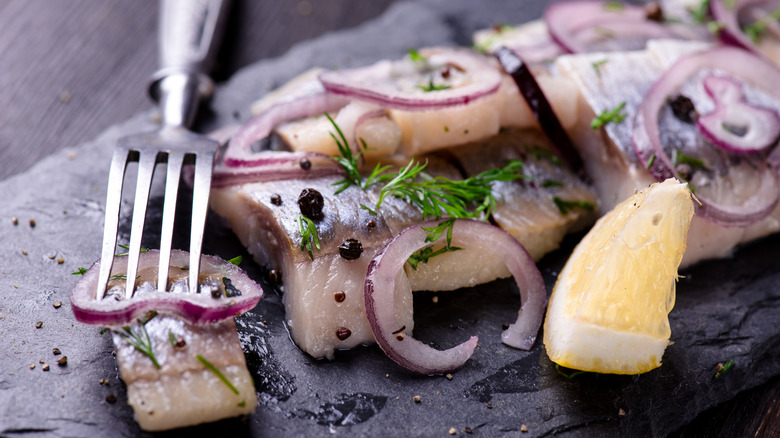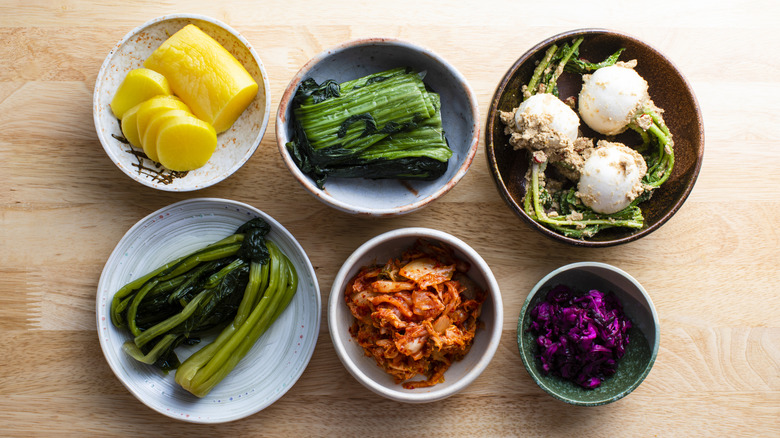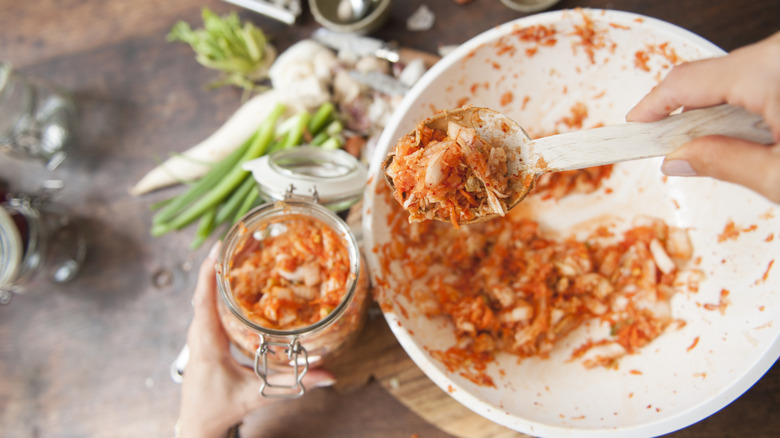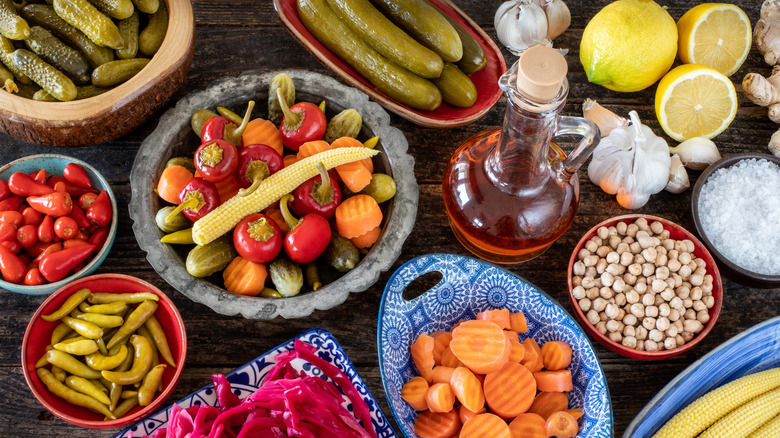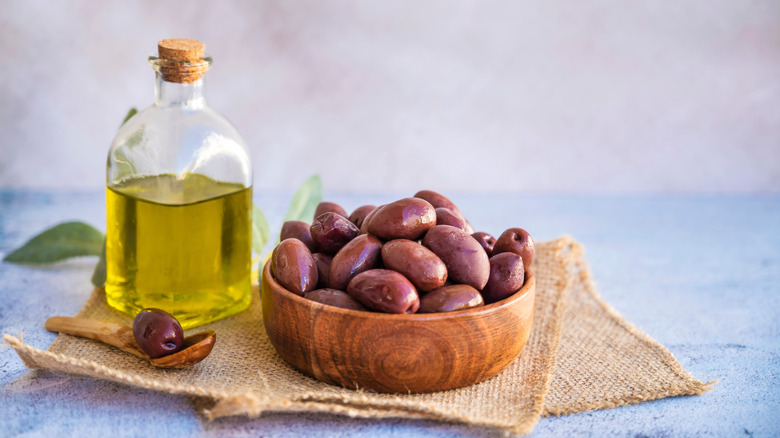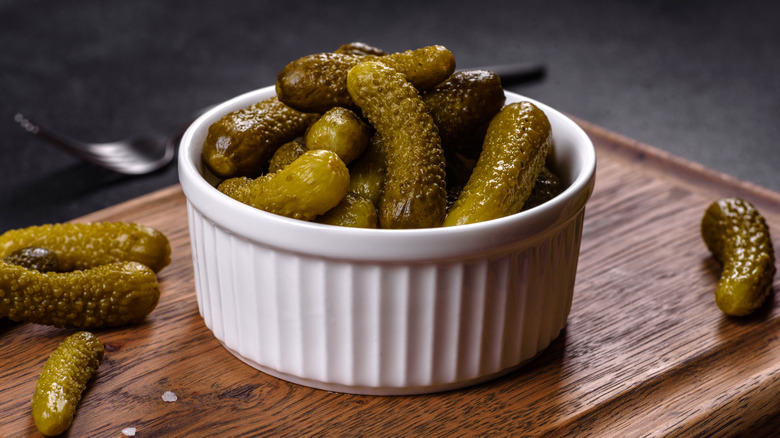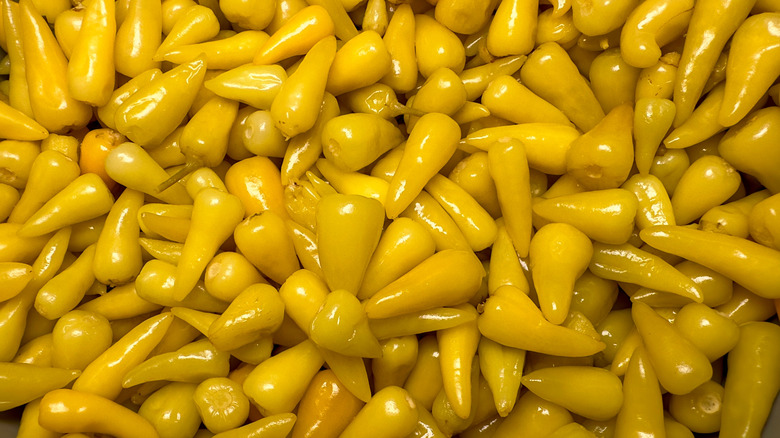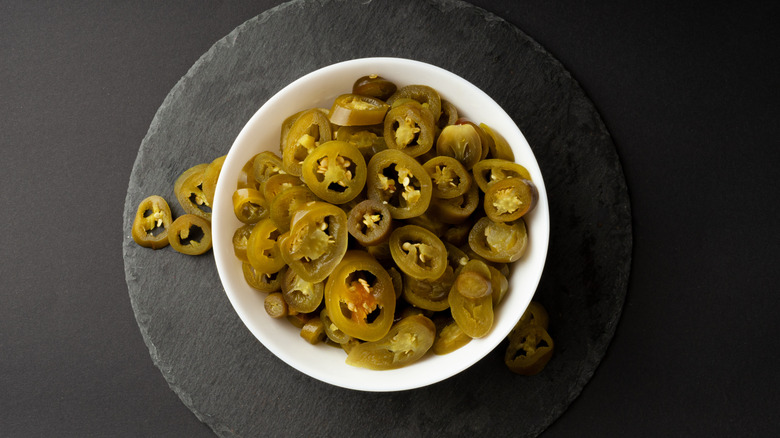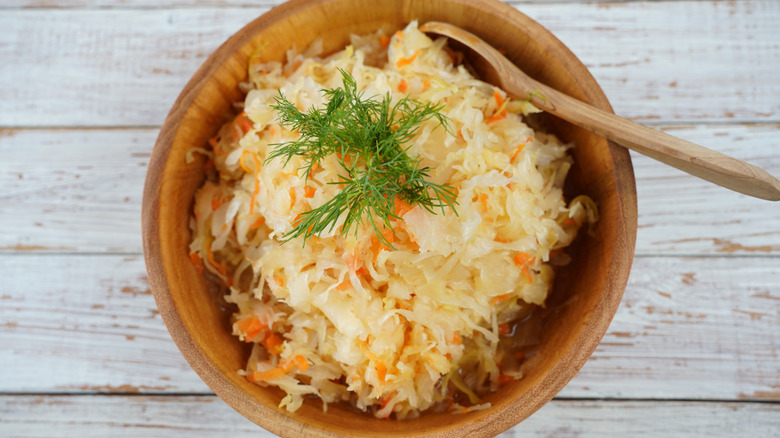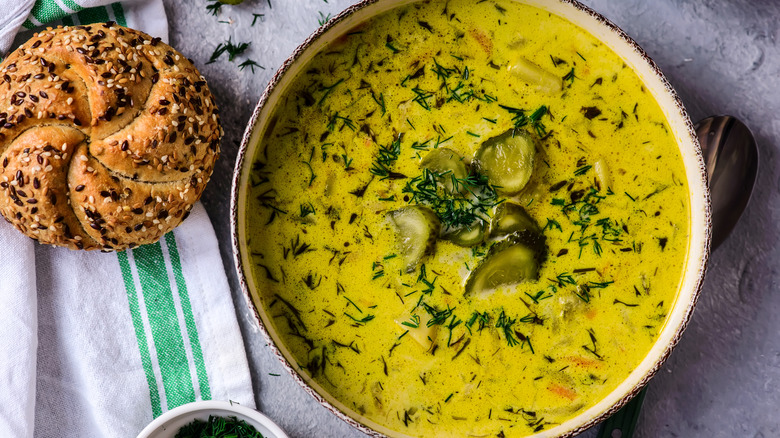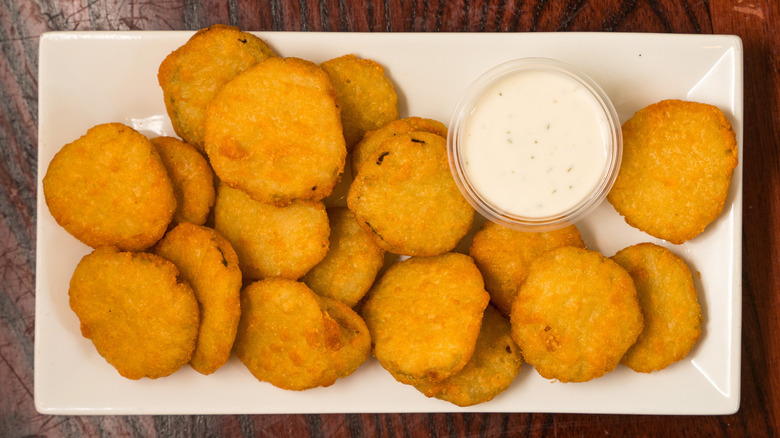12 Traditional Pickled Foods From Around The World
Pickling and preserving are age-old tactics to make food last. Long before refrigeration and international shipping, pickled foods and preserves were getting us through the winters. Pickling is a great way to extend the life of your produce, and the tangy, briny flavors add some much needed punch to many dishes and even drinks. But it's not only veggies that can be pickled. Different cultures around the world have been pickling for centuries, and they're going far beyond cucumbers.
Before we go deeper, you may be wondering what's the difference between pickling and fermenting. They are different but related processes, and some foods are actually made using both processes. Essentially, pickling relies on salt (and usually vinegar) to preserve foods, while fermentation uses bacteria to create more complex flavors. We will touch on some examples of both in this global roundup.
If you've never gotten beyond bread and butter vs. sweet pickles, there's a whole world to explore. From cabbage to fish to eggs, pickles come in all shapes and sizes. So, whether you're looking to try something new at a local restaurant or hone your home pickling skills, here are some punchy international pickles and fabulous fermented foods to explore.
1. Filipino atsara and dilis
According to chef and culinary educator Maricel Gentile, Filipino pickling "emphasizes a balance of sweet, tangy, and refreshing flavors." As such, most pickles from this region involve some amount of sugar as well as salt.
The most common and essential Filipino pickled dish is atsara. Atsara (or achara) is traditionally made from a mixture of grated green papaya, carrots, bell peppers, ginger, and onions. The pickling solution is a blend of vinegar, sugar, and spices, "resulting in a pickle that is crisp, lightly sweet, and vibrantly tangy," says Gentile. The vinegar used is typically cane or coconut vinegar, which lends a specific flavor. Unlike some pickles which are left to pickle for days or even weeks before consuming, Gentile says atsara is a quick-pickle dish, that means you don't have to leave it for days before eating. Its fresh vibrant flavors are "designed to complement the richness of hearty Filipino dishes like lechon (roast pork), barbecued meats, or fried fish."
Pickled fish, called dilis, is another common food in the Philippines often eaten with breakfast foods like garlic fried rice (sinangag) and can be cooked into the rice itself or served on the side. But you'll find them at lunch and dinner as well. "We also eat it as a snack with a cold beer," Gentile says, "and we use it for flavoring as an ingredient or as a topping on other dishes." Dilis are even used to make a fermented fish paste that is an excellent seasoning. That's one versatile pickle!
2. Scandinavian pickled herring
Filipinos aren't the only ones pickling fish. Europeans have been pickling herring for centuries. Herring is a type of small, oily fish found in the temperate waters of the North Atlantic and North Pacific. Herring were incredibly important in the history of European fisheries, and particularly in England, Sweden, The Netherlands, and Denmark where fishing was a major staple of the economy. They are eaten across Europe grilled, raw, smoked, and of course, pickled.
If oily little pickled fish doesn't sound appetizing to you, R.W. Apple Jr. did a deep dive on herring for the New York Times and assures that in the right hands, "pickled herrings are plump, firm and rich, suffused with the sweetness of the sugar and the contrasting tartness of the vinegar in their brine." And there are myriad ways to season and pickle the herring, with additional flavors like mustard and spices added into the brines. Pickled herring was commonly eaten for breakfast, and now makes for a tasty appetizer served with bread or boiled potatoes. It's also a common topping for the classic Scandinavian open-faced sandwiches, or smørrebrød. These smørrebrød are perhaps most famously found in Denmark. A typical Danish smørrebrød could have pickled herring, capers, onions, and dill on Danish Rye bread. But the Danes will also commonly serve cured herring in a curry sauce.
Naturally, herring isn't the only fish getting the pickle treatment. Gravlax is another delicious Nordic cured fish dish. Similar in appearance (and even taste) to smoked salmon and lox, gravlax is cured by preserving fresh salmon with a mixture of salt, sugar, and dill.
3. Japanese tsukemono
If you prefer your fish fresh, not pickled, and you've ever dined at a sushi restaurant, then you've probably encountered at least some pickled ginger. Often consumed as a kind of palette cleanser between bites of subtle fresh fish flavors, pickled ginger can also be a secret weapon to upgrade old favorites like the tuna sandwich. You may also have tasted Japanese quick-pickled cucumbers or seaweed salad. But Japanese pickling goes way beyond these sushi bar staples.
Tsukemono, as Japanese pickling is called, is an integral part of Japanese cuisine and culture, Chef Maricel Gentile explains, "it's not just about preserving food, but about enhancing flavors and bringing harmony to a meal." That harmony is evident in the subtle flavors of Japanese pickles. The simplest form, she says, is called shiozuke, "where vegetables are salted for a light and crisp taste." A more complex method, nukazuke, involves burying veggies in fermented rice bran, "creating an earthy, probiotic-rich pickle." This would be an example of a pickle that is also fermented.
Suzuke style pickling uses rice vinegar "for a tangy, slightly sweet flavor," while the shoyuzuke style "relies on soy sauce to add deep umami notes." Think about it, soya sauce is super salty, so it's perfect to use as a pickling brine. Yet another style, called kasuzuke, employs the use of sake lees for a uniquely sweet-and-savory pickle. "What I find most inspiring," Chef Gentile says, "is how pickles are treated with so much care," in Japanese cuisine. "They're not just sides; they're part of the meal's balance, both in flavor and aesthetics."
4. Korean Kimichi
At any Korean restaurant, you've probably encountered kimchi. Served on the side, kimchi is also cooked into many dishes. Kimchi is commonly made with napa cabbage and a blend of salt, garlic, ginger, scallions, fish sauce and Korean chili flakes. But kimchi is really an umbrella term that refers to this style of preserving vegetables and there are many varieties like radish, cucumber, and carrots. There are even some styles that don't include the signature red chili.
Kimchi is a food that best exemplifies the combination of pickling and fermentation. The vegetable ingredients are first salted to prepare them, and then left to ferment, so that "the bacteria work their magic to create those bold, tangy, bubbly flavors." Maricel Gentile recently had the chance to visit the Kimchi Museum in Seoul, and was inspired to see how central kimchi making is to Korean culture. "It reminded me of how fermentation and pickling can tell a story in every bite," she told us.
Gentile explained that pickling in Korea is very different from pickling in Japan. "Japanese pickling tends to be lighter and more subtle," she says, while Korean pickling, "often involves fermentation and bold spices." She explains that even quick pickles in Korea tend to pack much more seasoning compared to their Japanese counterparts. Korean pickling evolved, "not just for flavor but to preserve food through harsh winters, making it such an essential part of their culinary traditions." Pickling keeps veggies on the table long after they've stopped growing. And kim-jang, the tradition of communities getting together to make mass batches of kimchi to last through the season, is even recognized as a UNESCO Intangible Cultural Heritage. You can use classic Napa cabbage kimchi recipe to make some for yourself!
5. Turkish turşu
Working our way west a little, there's no shortage of pickles across the Middle East and Europe. Turşu is the Turkish word for pickle, and turşu can have a slightly different flavor profile than the pickles you might be used to grabbing at the grocery store in North America or even the parts of Asia already discussed. For one thing, they don't tend to be very sweet at all. Although there could be a little sugar in the brine, the typical turşu has an overall very tangy flavor. And they can be made in a spicy brine with garlic and herbs, using a base of salt and either a vinegar or lemon.
Cucumbers, cauliflower, bell peppers, carrots, green tomatoes, cabbage, and beets are all commonly pickled in Turkey. They can be sold separately or as a colorful mix. You'll find pickled cucumbers and hot peppers served along with kebabs and döner. The briny pickles help brighten these meaty and often fatty dishes. Some Turkish pickles can be quite spicy, so make sure to take a little nibble before popping a whole pepper in your mouth!
6. Greek pickled onions and Kalamata olives
On the western border of Turkey you'll find Greece, these neighbors share many ingredients, especially around the Mediterranean. In fact, though the winters are much milder, you'll find loads of pickles across the Mediterranean region. Chef Owen Klein heads up the kitchen at CAVA and assures there is a rich history of pickling, brining, and preserving in the region.
Brine is another word you'll often hear in the world of pickling. A brine is a solution of water and salt, though other seasonings can be incorporated, and Klein explains, "brining over time causes fermentation and lots of flavor changes within the vegetables." In the Mediterranean and Levant region, he says, "it is the flavors and base vegetables that set it apart from other cuisines." Flavorful cucumbers, carrots, cauliflower, bell peppers, pepperoncini, capers, olives, and onions all get the briny treatment.
A lot of olives, in particular Greek Kalamata olives, are cured in brine. That makes them a kind of pickle! Straight off the tree you wouldn't even be able to eat them, and they wouldn't have that signature saltiness. "Our pickled onions are sweet and tangy, our salt-brined pickles add a seasoned and fermented depth, and our Kalamata olives are unctuous and salty," says Klein. He believes pickling techniques add depth and layers to food and bring ancient food preservation methods into the contemporary world. And while most of us modern folks haven't taken the time to make our own preserves, Klein feels confident, "Gen Z and millennials appreciate food with a rich story that takes time to develop." Let's hope we keep these essential flavors going!
7. French cornichons
Cornichons are the famous little French pickles that pack a serious punch! Resembling gherkins, cornichons are extra tart, bumpy little pickles that you'll almost certainly find on any proper charcuterie board. In France, cured meats and cheeses are often served with some pickles, mustard, and even a bit of jam or honey. The combination of sweet, sour, and fatty flavors is super satisfying.
They're not dissimilar to other gherkins, but the typical cornichons are pickled with mustard seeds and tarragon, and are often jarred along with little pearl onions. They're certainly less sweet than their German counterparts, but offer a more complex flavor compared to other pickles. You can chomp on one straight up, but cornichons are an excellent alternative to larger pickles when chopped up in an egg salad or tuna salad. They're also a fun garnish to add in your savory cocktails (such as Bloody Marys or dirty martinis).
8. Italian pickled peppers
Italians are pickling all kinds of veg like their neighbors in the region, but when you think of Italian pickles, peppers are at the top of the list. Some sweet, some spicy, some salty, these little pickled peppers are often found at the olive bar in your local grocery store or deli. Pepperoncini, banana peppers, cherry peppers, and chopped hot peppers all add a pop of color and flavor to the table. And yes, there are differences between banana peppers and pepperoncini, starting with their color! Peppers can be pickled sliced into rounds, whole with their stems intact, or stuffed with cheeses, fish, or cured meats.
Along with other pickled foods like olives, they make a powerful appearance in the Italian antipasto course. They might also be toppings you've experimented with adding to your sub sandwiches. And for a twist on a classic, try garnishing your next dirty martini with pepperoncini instead of (or in addition to) olives!
9. Mexican escabeche
The Italians aren't the only ones pickling peppers. Pickled jalapeños have become somewhat of a staple ingredient, and you'll probably find them in your grocery store. They're perfect to add a kick to your nachos and tacos. In fact, you might find a number of pickled foods amongst the typical taco toppings. Quick pickled red onions are a go-to. A lightly pickled cabbage slaw is another great topping that brings some zest and crunch to every bite. And back to those jalapeños, escabeche is a quintessential side made with marinated pickled peppers, carrots, and sometimes onion.
There are different types of escabeche found around Latin America and beyond. Escabeche probably originated in Spain, but even then the term was drawn from Arabic. In the Mexican context, it does tend to refer to that mix of peppers and carrots, but there are other vegetables (like cauliflower) that can pop up. The main difference between these and other quick pickles is the addition of olive oil to the brine. It's not difficult to make some for yourself, but you can pick up a jar at the store if you prefer. Next time you've got some pickled jalapeños, make sure you don't skip the best part and use the brine!
10. Eastern European sauerkraut
Sauerkraut is pretty ubiquitous. A common sausage topping and pierogi stuffing, it is made from shredded cabbage. The name we use comes from the German, sour cabbage, however, Sauerkraut is commonly eaten across Eastern Europe and beyond. The history of sauerkraut is global. Polish, Russian, Ukrainian, Germany, and other neighboring cuisines feature cabbage and its pickled incarnation, sauerkraut, heavily.
Sauerkraut is basically the kimchi of Eastern Europe. Though there are several major differences between sauerkraut and kimchi. Firstly, you won't find any ginger or chili flakes in your sauerkraut (but you may find some caraway seeds), and it won't be red, unless it's made with purple cabbage. The key thing the two have in common, though, is that they are fermented. Many espouse the probiotic benefits of these fermented foods to your gut health, but be advised, not all sauerkraut sold in shops has live bacterial cultures. So, once you understand the science of sauerkraut fermentation, make sure to read the label on the jar you're purchasing if that's part of the draw for you.
11. Polish Pickle Soup
If you already love them and just wish you could eat pickles for dinner, then you definitely have to try Polish pickle soup. It's pretty much exactly what it sounds like, but even better. Made with a soup base of onion, carrots, and potatoes, with pickles (and some of their brine), and added fresh dill and sour cream or regular cream. The typical pickle soup has that creaminess that really elevates the dish, but if you're making some for vegan friends it's not hard to skip the dairy. You can thicken the soup with a little flour if you like, or leave it brothy.
Some recipes incorporate additional spices, or use homemade chicken broth, but it's a pretty simple recipe overall. Warm, hearty, and quick and easy to make, pickle soup is often served with a hunk of bread. This is a classic Polish dish, but you'll find versions of it in neighboring countries like Ukraine, Lithuania, and Russia.
12. American fast food pickles
Of course you've heard of pickles long before reading this, we've got loads of them right here in the U.S. Not only is this country a composite of immigrant cultures and their respective cuisines (ensuring you can find all of the above mentioned pickles somewhere stateside), but also we've produced a few home grown techniques and specialty pickles. Many regional favorites incorporate pickles. Down South, you might encounter deep fried pickles, and dill pickle spears and relish are among the traditional toppings of the famed Chicago-style hot dog.
A traditional German snack food, pickled eggs made their way to the United States when folks immigrated to North America. The Pennsylvania Dutch still commonly make them, and pickled eggs have since made their way into the American scene. But you can also find them in the U.K. and other places. If you're curious, you can try this ingredient to upgrade homemade pickled eggs. And if you're not convinced, you can start by adding a little chopped pickles to your next batch of egg salad, or a splash of vinegar to your deviled eggs.
